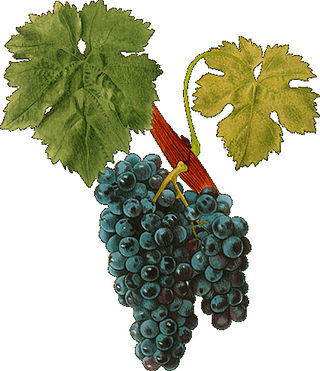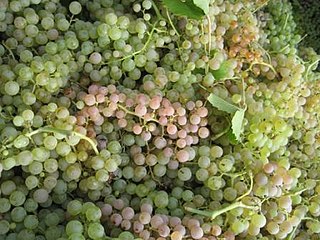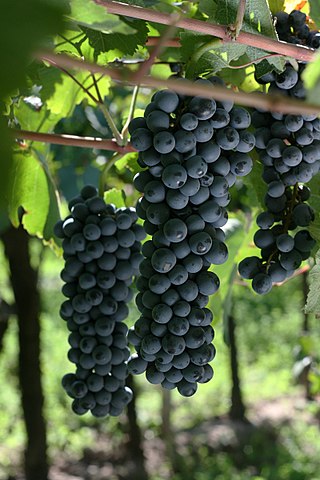
Carignan is a red grape variety of Spanish origin that is more commonly found in French wine but is widely planted throughout the western Mediterranean and around the globe. Along with Aramon, it was considered one of the main grapes responsible for France's wine lake and was a substantial producer in jug wine production in California's Central Valley but in recent years, it has been reborn as a flagship wine for many cellars in the south of France as well as in Catalonia.

Barbera is a red Italian wine grape variety that, as of 2000, was the third most-planted red grape variety in Italy. It produces good yields and is known for deep color, full body, low tannins and high levels of acidity.

Garganega is a variety of white Italian wine grape widely grown in the Veneto region of North East Italy, particularly in the provinces of Verona and Vicenza. It is Italy's 6th most widely planted white grape. It forms the basis of Venetian white wine Soave and is also a major portion of the blend used to make Gambellara.
Uva Tosca is a red Italian wine grape variety that is grown in the Emilia-Romagna region of east-central Italy where it is the only grape variety able to grow in the higher elevations of the Val Secchia area. Despite what its name may allude to, ampelographers have little evidence to believe that the grape originated in Tuscany or has any close genetic relationship with the notable Tuscan wine grape, Sangiovese, that is also known under the synonym of Uva Tosca. In 2010, DNA analysis suggested that Uva Tosca may be a natural crossing between the Alto-Adige wine grape Schiava Grossa and Crepallocchi.
Albaranzeuli bianco is a white Italian wine grape variety that is grown primarily in Sardinia. Ampelographers use to believe that the grape was originally Spanish in origin and was introduced to the island when it was ruled by the Crown of Aragon. Recent DNA profiling has suggested that the grape may have originated on the island as a crossing between the red Sardinian wine grape Girò and the Spanish table grape Molinera, known locally as Pansa Rosa di Málaga and distinct from the Veneto wine grape Molinara that is used in Amarone. A pink skinned grape known as Albaranzeuli nero is also found in Sardinia but its exact relationship to Albaranzeuli bianco is not yet clear.
Rossola nera is a red Italian wine grape variety that has been growing in the Valtellina region of Lombardy since at least the 17th century. In 2004 DNA profiling determined that the grape has a parent-offspring relationship with the Piedmont wine grape Nebbiolo though which variety is the parent and which is the offspring is not yet clear. However, most ampelographers believe that Nebbiolo is likely the parent variety since written records in Piedmont have noted Nebbiolo being grown since at least the 13th century.

Douce noir is a red Savoyard wine grape variety that has historically been grown in the Savoy region, but today is more widely planted in Argentina. The earliest mention of the grape dates from when Etruscans first planted Bonarda some 3.000 years ago in the Padana Region. It arrived in Savoie in the early 19th century, and by the end of the century it was the most widely grown red wine grape in the region. In the early 21st century it was discovered that the Bonarda grape, which is the 2nd most widely planted red grape, after Malbec, in Argentina was the Italian wine grape Bonarda Piemontese imported by Italian immigrants. The grape is also grown in California where it is known as Charbono.
Barbera bianca is a white Italian wine grape variety that is grown in the Piedmont wine region of northwest Italy. Despite being named Barbera bianca, the grape is not a color mutation of the red Piedmontese wine grape Barbera that is the third most widely planted grape variety in Italy. In fact, DNA analysis conducted in the early 21st century shows no genetic relationship at all between the two grape varieties.
Cascarolo bianco is a white Italian wine grape variety that is grown primarily in the Piedmont wine region of northwest Italy. The grape has a long history in the region and was noted in 1606 by Giovanni Battista Croce, vineyard owner and official jeweler to Charles Emmanuel I, Duke of Savoy, as growing in the hills around Torino and producing wine of high esteem. It was once thought that Cascarolo bianco was the same variety as the Hungarian wine grape Fehér Gohér but DNA profiling in the early 21st century determined that the two grapes are unrelated. Today ampelographers believe that the grape is an offspring of the Swiss wine grape Rèze with DNA evidence suggesting some relationship with another white Piedmontese grape, Erbaluce.
Grisa nera is a red Italian wine grape variety that is grown in the Piedmont wine region of northwest Italy where it is used in both winemaking and as a table grape. The grape is most often used as a minor blending component with wines made from Barbera, Neretta Cuneese and Plassa.
Giró blanc is a pink-skinned Spanish wine grape variety grown in the Balearic islands where it used in white wines produced under the Illes Balears appellation. Ampelographers believe that the grape is indigenous to Majorca with DNA profiling showing no known relationship to the Sardinian wine grape Girò or to Grenache which is known as Girò on Majorca.
Termarina rossa is a red Italian wine grape variety that is grown in the Emilia-Romagna region of northern Italy. The grape is unique among Vitis vinifera varieties in that it is naturally seedless. Historically Termarina rossa was grown in the provinces of Parma and Reggio Emilia for use in production of jams and saba, a sweet syrup, made from boiling the must but today it is used as a blending variety in some of Indicazione geografica tipica (IGT) wines of the area.
Avanà is a red Italian wine grape variety that is grown in the Piedmont wine region of northwest Italy. Historically, the grape has also been grown in the Dauphiné and Savoie wine region of eastern France where it was known as Hibou noir and in the Valais region of Switzerland. The grape is most often used as a blending variety in the Denominazione di origine controllata (DOC) zones of Pinerolese, with Barbera, Persan, Freisa and Neretta Cuneese, and Valsusa, with Barbera, Dolcetto, Neretta Cuneese and other local red Piemontese varieties.
Avarengo is a red Italian wine grape variety that is grown in the Piedmont wine region of northwest Italy where it is a permitted blending component in the Denominazione di origine controllata (DOC) wines of Pinerolese. Here the grape is usually blended with Avanà, Neretta Cuneese and other local red Piemontese varieties.
Forastera is a white Italian wine grape variety that is grown on the islands of Ischia and Procida off the coast of Naples in Campania. In the early 21st century, DNA analysis confirmed that the Spanish wine grape variety of the same name grown in the Canary Islands is a completely different and distinct variety with no close genetic relationship to the Italian Forastera.
Barbera del Sannio is a red Italian wine grape variety that is grown in the Campania region of southern Italy. Despite the similarities in name and appearance, the grape has no close genetic relationship with the Piedmont wine grapes Barbera or Barbera bianca or the Sardinian wine grape Barbera Sarda and is, instead, more closely related to the Campanian varieties Casavecchia and Catalanesca and the Apulian grape Nero di Troia.
Uvalino is a red Italian wine grape variety that is grown in the Piedmont wine region of northwest Italy. While the name uvalino means "small berries", ampelographers believe that the name may be derived from uvario which in the local Piedmontese dialect was used to denote wine grapes that were primarily minor blending varieties.
Bianchetta Trevigiana is a white Italian wine grape variety that is grown in the Trentino-Alto Adige/Südtirol and Veneto wine regions of northeast Italy. Here the grape is rarely used a varietal but, instead, is a permitted blending grape adding acidity to the wines of several Denominazione di Origine Controllata (DOC) zones including the sparkling wine Prosecco and has also been used for vermouth production. The name Trevigiana is derived from the province of Treviso where the grape is believed to have originated from.
Biancone di Portoferraio is a white Italian wine grape variety that is grown almost exclusively on the island of Elba off the coast of Tuscany. Some ampelographers have speculated that the grape may have originated on the French island of Corsica where the grape shares a close genetic relationship with the Corsican wine grape Biancu Gentile.
Bonda is a red Italian wine grape variety that is grown in the Aosta Valley region of northwest Italy around the communes of Châtillon and Quart. Historically the grape has been confused with another grape of Aosta, Primetta, but DNA analysis in the early 21st century showed that the two grapes were distinct and not closely related. Despite being known under the synonym of Prié rouge, Bonda is not a color mutation of Prié blanc nor do the two grapes seem to be closely related.





